Teacher Guide Graphic Organisers
Affinity diagram
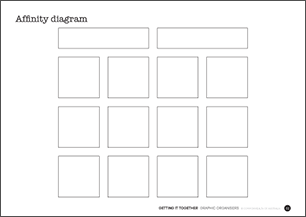
Purpose:
To group ideas into categories or themes.
Procedure:
Record the results of a brainstorm by placing an organising theme
or heading in the top boxes. Write similar concepts or items below
each theme or heading.
Concept map

Purpose:
To define a concept by identifying its elements or attributes.
Procedure:
Write the concept in the centre circle. Record its attributes or elements in the outer circles.
Consequences chart
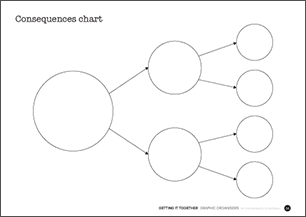
Purpose:
To explore options when making decisions.
Procedure:
Start with a ‘what if’ question or problem and write it in the circle on the left. Students suggest solutions to be written in the middle circles and the possible consequences of each solution Action in the circles on the right.
Diamond ranking chart

Purpose:
To prioritise a list of nine statements or pictures in order What I know of importance.
Procedure:
Write items to be ordered on separate pieces of paper. Place the most important at the top and the least important at the bottom. Place the two next most important and two least important, with the three remaining being neither important nor unimportant.
Fishbone diagram

Purpose:
To provide a systematic way of considering a problem.
Procedure:
Write the problem in the fish’s ‘head’. Use the ‘bones’ for the questions – how, when, where, why and what. You can modify this diagram to incorporate a different de Bono ‘thinking hat’ at the end of each stem to direct students’ thinking.
Flow chart

Purpose:
To represent a sequence of events.
Procedure:
Write or draw events or activities in order in each box. Other boxes can be added to show related events.
Futures line

Purpose:
To consider two possible futures.
Procedure:
List aspects of a probable future if things were to continue as they are now, and ideas about what the future could be like if particular actions were taken to shape it.
KWHL chart
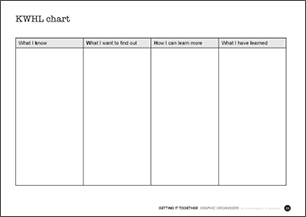
Purpose:
To establish what is known and what needs to be found out to complete an investigation.
Procedure:
Students define their information requirements in a research activity, and to reflect on what was learned. What is already known is recorded in the first column, and any further research needs are identified in subsequent columns.
Placemat
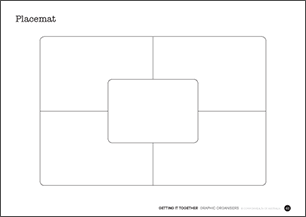
Purpose:
To consider one’s own opinions before negotiating a group response to an issue.
Procedure:
Each group member has a section to write in. The square in the middle is to record the group response. Students are given an issue, topic or question to consider. They record their individual responses. They share their responses and as a group decide the response to be recorded in the middle.
PMI – plus, minus and interesting
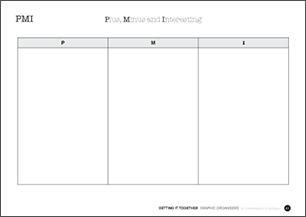
Purpose:
To evaluate thoughts about an issue and clarify issues for further investigation.
Procedure:
Students list the Pluses (positives) of an issue in the first column, the Minuses (negatives) in the second column. In the third column, they list elements that cannot be classified precisely as positive or negative as Interesting.
PNQ – positives, negatives and questions

Purpose:
To evaluate thoughts about an issue and clarify issues for further investigation.
Procedure:
Students list the Positives of an issue in the first column, the Negatives in the second column. In the third column, they list Questions for further investigation.
T-chart

Purpose:
To classify ideas or issues supporting or negating a proposition.
Procedure:
On either side of the line, children list opposing aspects of an idea or issue that is written at the top. The nature of the two sides (eg ‘opinions’ and ‘facts’) is determined by the teachers and students, depending on the type of thinking to be undertaken (eg critical, analytical or creative).
Venn diagram
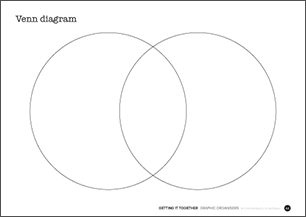
Purpose:
To compare the similarities and differences between two or more groups of people, places or issues.
Procedure:
Write the items being compared in the circles. Where the circles overlap, record similarities. Record the characteristics which are different in the areas that do not overlap.
Web map

Purpose:
To assist in activities that involve planning, brainstorming, making notes, organising or problem solving.
Procedure:
An issue or topic is written in the centre. Related ideas are linked to the central issue and other ideas are developed from these. Use lines, colours, labels and arrows to show links between ideas.
X-chart
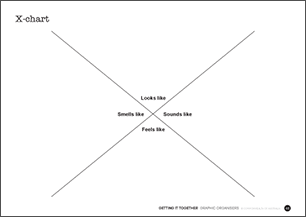
Purpose:
To brainstorm ideas based on what we would see, hear, smell and feel in a given situation.
Procedure:
List ideas in each section as labelled – looks like, sounds like, smells like, feels like.
Y-chart

Purpose:
To brainstorm ideas based on what we see, hear and feel.
Procedure:
List ideas in each section as labelled – looks like, sounds like, feels like.